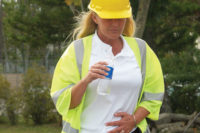Hitting heat stress head on
Do you know your personal risk factors?

In the summer of 1983 I was in Portland, Maine, with my family. We’d just spent the afternoon walking around the downtown and enjoying a rousing jazz festival. The day was sultry; a warm breeze blew in from the Atlantic, carrying with it the scents of the sea. I should have been having fun, but I felt woozy. My teeth tingled and my vision blurred. I broke out in a cold sweat… and that’s where my memory gets hazy.
I’m told a nurse who happened to be there that day helped my family get me into an air-conditioned building; remove my fashionable-but-warm sweater vest (remember, this was the 80s); and give me sips of cool water. The attention, while embarrassing for a teenager, probably saved my life. I was experiencing heat exhaustion. If not treated properly, heat exhaustion can lead to heat stroke — a life-threatening situation.
I was young, fit, and on vacation, which just shows that heat-related illnesses can happen to anyone. But heat stress is much more likely to be experienced by someone laboring in hot conditions, especially if he or she is wearing protective work clothing, such as boots, gloves, and protective headgear.
Recognize the signs and symptoms
Employees need training to understand heat stress and protect themselves from its adverse effects.
Any time employees are exposed to heat, their bodies are under heat stress. Heat stress occurs when the body has to work harder to maintain a stable core temperature. When a person works in a hot environment, whether indoors or outdoors, the body is challenged to get rid of excess heat.
Risk factors
Workers should understand their own personal risk factors for heat stress. A person’s sensitivity to heat can be affected by physical factors such as:
- Age
- Weight
- Cardiovascular health
- Metabolism
- Medications
- Water consumption
- Caffeine consumption and
- Other medical conditions.
- Other factors that can contribute to the likelihood of experiencing a heat-related illness include:
- Air temperature
- Humidity
- Air exchange
- Heat sources
- Level of exertion
- Type, amount, and characteristics of protective clothing worn
Recognize signs and respond
A good training program will instruct employees in how to recognize a heat-related illness in themselves or coworkers and what response to take to keep the situation from getting worse.
Heat stroke
Heat stroke is a life-threatening condition that occurs when the body is unable to cool down through sweating. Someone suffering from heat stroke may have the following signs and symptoms:
- Confusion
- Irrational behavior
- Loss of consciousness
- Convulsions
- Hot, dry skin (no sweating)
- Very high body temperature
Respond: Quick action is needed in the case of heat stroke. Employees should know how to activate the emergency medical system by calling the company emergency medical responders or 911. The worker should be seen by a medical professional immediately.
In addition, co-workers should move the employee to a cool, shady area, preferably one that is air-conditioned, and outer clothing should be removed. The skin should be wetted, especially at the ankles, wrists, armpits, groin, and neck. Increase air circulation around the worker and give cool fluids to drink. Never leave the worker unattended.
Heat exhaustion
Heat exhaustion, while not immediately life-threatening, requires prompt first-aid treatment. Heat exhaustion can develop into a more serious situation. Someone experiencing heat exhaustion may have the following signs and symptoms:
- Headache
- Nausea
- Vertigo
- Weakness
- Thirst
- Giddiness
- Muscle cramps
- Fainting
Respond: Train employees to move the employee to a cooler environment immediately. Remove outer clothing and give cool fluids to drink. The worker should be encouraged to rest. Watch the employee for signs the condition is getting worse.
Heat cramps
Heat cramps are thought to be brought on by an electrolyte imbalance caused by sweating combined with inadequate fluid intake. Cramps are also associated with extreme physical labor in hot environments. A worker with heat cramps may experience:
- Involuntary painful muscle spasms
- Excessive sweating
Respond: Train employees to move the employee to a cool area and offer replacement fluids — especially electrolyte drinks such as sports drinks. The employee should gently stretch the cramping muscles and rest.
Heat fatigue
Heat fatigue is common in workers who haven’t had time to adapt to a hot work environment. Someone experiencing heat fatigue will have trouble concentrating and working.
Respond: Train employees to watch for signs of impaired performance in themselves and coworkers. First aid involves moving to a cooler location and resting. Heat fatigue can progress to a more serious situation if not treated promptly.
Heat rash
Heat rash, which is often called “prickly heat,” is a common condition in hot work environments. A worker with heat rash will have red bumps on the skin; sweating makes the bumps feel itchy or “prickly.” Heat rash occurs most often under tight clothing or where skin rubs on skin. Usually, the condition clears up on its own, but heat rashes can become infected.
Respond: Train employees to treat heat rash by drying the skin and keeping it cool. Prickly heat can be soothed by rinsing the affected area with cool water and then drying the skin.
Because anyone can experience heat stress, especially when working hard in a hot environment, employees should know the signs and symptoms of heat-related illnesses and how to respond effectively.
Looking for a reprint of this article?
From high-res PDFs to custom plaques, order your copy today!





